Urban Foraging is increasingly relevant for a number of reasons.
Through this piece, we’re going to take a deep dive into everything Urban Foraging.
When most people think of foraging, they probably imagine scenes of rural idyll. They imagine striding out into unspoilt, wild places, far from the madding crowd. However, according to Government statistics 83% of the UK population lives in towns and cities, and it seems a shame to think that we’d all have to wait for a trip outside the suburbs in order to practise finding a wild lunch. The good news is that nature is indomitable, as we humans like to think we are. It can thrive in the most hostile and changeable environments. Lots of edible species are common and adaptable, and very happily grow alongside and amongst our roads and buildings. With all the well-known benefits of spending time outside in green space, why not sharpen your plant and fungus spotting skills in your local park or on a walk round the block? In this blog I’ll talk about staying safe and legal, then in Part 2 I’ll explore the various species you’ll be likely to find.
Foraging and the Law
Foraging for your own personal consumption is legal in the UK, but with some important caveats – you need to know that the species you are picking is common and not endangered in any way, and you need to know what kind of land ownership arrangement is in place. (Have a read of Fez’s piece on Foraging and the Law for more detail, including the differences in Scotland compared to England and Wales ). Most land is privately owned, so the laws of trespass apply and you shouldn’t really be on there without the landowners permission, or unless its designated Right to Roam as in Scotland. However, even in heavily privatised and built up areas, not everywhere is completely off limits – basically if on a public footpath or other right of way, you are OK to be there and to forage responsibly. Look up on Ordnance Survey maps to see where public rights of way go – you can also borrow the physical maps from your local library.
The same logic applies to Common Land – there isn’t much of it left, but you may find the odd neglected scrap that hasn’t yet been built on. In such a place, anyone has a legal right to be, to forage, and even to graze animals according to ancient laws! Parish records (again, worth asking at the Library or Council Archives for a start point) may help you identify one near you where you can legally bring, for example, a guinea pig to graze alongside you.
It’s obviously trespassing if you go into somebody’s garden, but if a plant is dangling over the fence or wall into the street or other Public Right of Way, then it’s OK to pick only the bits on the public side.
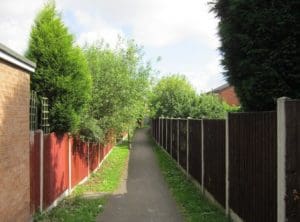
By A public footpath off Lowry Road by Ian S, CC BY-SA 2.0, https://commons.wikimedia.org/w/index.php?curid=114295925

By No Public Right Of Way by David Dixon, CC BY-SA 2.0, https://commons.wikimedia.org/w/index.php?curid=113825273
It’s completely fine to hang out in Public Parks just to practice identifying plants, and I’d say it’s a very good use of your time even if you don’t take any home. Many have their own specific bylaws concerning foraging, and it will likely be different from park to park depending when they were laid out. Your Local Council website should hopefully give more information about the parks they legally own and run. They can tell you if some parks are actually owned by private developers instead, as is becoming more common. If you can spot that rare species, the Park Ranger, they might be able to tell you what the rules are and where they are written down. It’s always wise to be polite to such people – after all, they are just trying to do their job. It’s up to you to keep foragers’ good reputation and not get us all banned, but it’s also well worth getting to know them because they likely know the local area very well. If they can see that you are a careful and sustainable forager and not causing damage, they may be able to tell you where to find interesting species, or even direct you where to help control invasive species by eating as much as possible!
Safety
Secondly, having worked out where you are allowed to go, have a think about staying safe. Cities aren’t necessarily more dangerous than the top of a mountain, its just a slightly different set of hazards to keep in mind – and you know your own neighbourhood best, so apply some common sense. Just the same as if you were exploring the countryside, you should have a phone, some way of navigating, and have someone know where you are. Go in daylight, and ideally take someone with you – basically take the obvious precautions not to end up lost in an unfamiliar place on your own after dark.
Climbing over walls and fences to trespass risks injury as well as prosecution, so don’t bother. Likewise some species such as Himalayan Balsam like to grow on steep slopes and river banks – don’t risk falling over or falling in, there will always be somewhere safer to harvest from (especially with that species)
By far the biggest Urban hazard is road traffic as you go along the pavement or cross the road. Unfortunately traffic doesn’t always stay on the road- it will be important to keep alert for cars and bikes, and for this reason it’s not wise to have earphones in as that might stop you hearing an approaching engine or a warning bikebell. This is true on small footpaths as well as major roads – I’ve spent a fair bit of time on canal towpaths, and it’s unfortunately all too common for a speeding bike to come under a bridge without looking out for pedestrians, with the outcome that someone ends up in the water or in a crumpled heap!
Hostile humans could be a concern in certain areas and times of day, though of course most people are lovely and will either leave you well alone or just be curious as to what you’re doing in their neighbourhood. Stay friendly, but alert to any weird vibes and don’t hesitate to leave quickly if anybody makes you feel uncomfortable. Even if you know you have a perfect right to be there, it’s never worth getting into a fight over it. Homelessness also unfortunately still exists, and it’s possible you could stumble across someone sleeping rough or a tent tucked away somewhere. If they have picked a hidden corner out of the way it’s safe to assume they don’t want to be disturbed, and will have had no option but to find a bush for a toilet . Remember that even if you’re annoyed by a mess, that is a human being trying to deal with a bad situation – the kind and prudent thing to do is just move on, respect their privacy and pick somewhere else.
Fly-tipping and litter aren’t just unsightly, they can leave lots of sharp edges that can be hidden by leaves and long grass. If you suffer a cut (or rare but not impossible, a needle stick injury) you must get it seen by a doctor. Just like in rural areas, it’s a good idea to have your tetanus jabs up to date just in case. Dog, cat or even human poo and pee can also be a concern on heavily used footpaths or in hidden corners where people like to hang out under the influence, so I’d avoid picking there, and move a metre or more back from the edge of the path to stay out of the ‘dog zone’. Basically, please be careful when rummaging about in the undergrowth, and never put your hand anywhere without looking first! You don’t want to get pricked while you pick.
Contaminated ground is also a concern for some post-industrial sites, though it depends a lot on what kind of industry it was, how well the land has been cleaned up afterwards, and what species you would be interested in foraging. Heavy metals in the soil can be taken up by some species but not others, for instance Amethyst Deceivers are known to accumulate arsenic. It is sometimes possible to find out about soil quality in areas that have a history of heavy industry, mining or fly tipping of unpleasant chemicals, and we do have scientific information about how much some species take up so it’s always worth searching or asking local experts to find out what you can. You might come to the conclusion that there’s nothing to worry about. However for many species and many sites there is just no information in the public domain, so personally I apply the If In Doubt, Leave It Out principle if the land looks obviously polluted, for instance if the ground or water is a funny colour, or the plants look burnt, yellowed or stunted. Likewise I move on if I know there used to be heavy polluting industry there, or if I see signs of people camping out or gathering to drink or take drugs, or if there’s a lot of fly tipping. Sometimes just moving 100 metres further on is enough to get to a much nicer patch.
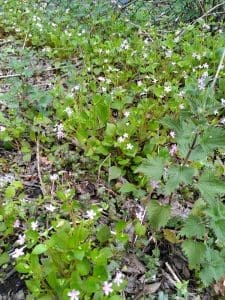

So in summary, here are my quick tips for staying safe in the city ( or town, or countryside – its all relevant anywhere really!):
- Take your phone with you, and make sure someone knows where you are going and when to expect you back. Even better, go out with trusted friends.
- Never forage with headphones in – they can obscure your awareness of vehicles, bikes or hostile humans
- Don’t trespass, and especially don’t be climbing over walls and fences, steep slopes, or near water.
- Always look where you are putting your hands and feet, be careful of accidentally touching something sharp or gross.
- Look out for obvious industrial pollution, fly-tipping, signs of human or dog waste, and avoid. Thankfully these areas are usually small and contained and you’ll likely find somewhere cleaner nearby.
- If you stumble upon signs of somebody sleeping rough, just respect their privacy and move on.
- You have as much right to be out in public places as anyone else – but its not worth getting in a fight over so just leave if anyone is making you feel threatened.

With all that said, most problems are confined to relatively small areas and with a bit of exploring you will find a variety of habitats in any urban area that are safe and well worth exploring.
What to Find when Urban Foraging
In this part of the blog I’d like to highlight what to forage in an urban environment, looking at a few common species of edible plants and fungi that you might find in any urban or built up areas in the UK. There are actually a huge variety to look for, from the hardy and adaptable ‘weeds’ that just grow where they want, to things deliberately cultivated by people in parks and gardens. Some species are just as common in the countryside and have been used for food for centuries, while others might be more unusual introduced species that you would only find if a person had brought them in on purpose and carefully looked after them. And yet others have started out as garden plants but then enjoyed themselves a little too much and gone invasive – in which case foraging them to eat is actually helping maintain them in balance with other plants for greater biodiversity.
I’ve divided these up into some different types of habitat, but to be honest many of these plants are tough and adaptable and will grow just about anywhere. One of the major joys of urban foraging is seeing how determinedly life finds a way!
Pavement/hard landscaping:
Hairy Bittercress and Herb Robert, grow readily in cracks in the concrete or in even the tiniest pockets of poor dusty soil. Broad-leaved plantain can handle heavy trampling so comes into its own in places with heavy footfall.
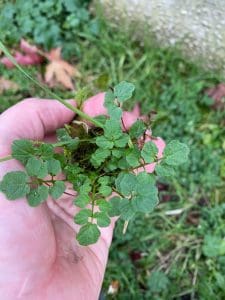
Public park/ sports fields – short grass:
Plants that can handle bright sunlight and frequent mowing might be small, but they hold their own in patches amongst the grass. Clover, Daisy, Dandelion, Pineapple weed, Yarrow, Broadleaved and Ribwort plantains all go well in a salad. If you need bigger leaves, look in longer grass, perhaps round the edges of the space. As for fungi, you could potentially find any grassland species, for instance Giant puffballs, Shaggy Ink caps, Agaricus species such as Horse Mushrooms or Field mushrooms. You might occasionally find quite rare species in old parts of town where the ground isn’t dug over often or has been kept undisturbed by agriculture for a few centuries – for example graveyards and parkland around stately homes sometimes support colourful Waxcaps

Long grass:
Cow Parsley, Hogweed, Yarrow, Ribwort plantain, Chamomile (especially in deliberately planted wildflower areas),

Gardens/ ornamental planting:
You might find these shrubs and trees freely accessible in a park, or hanging over a garden wall, or spreading onto waste ground or open areas from the first two!
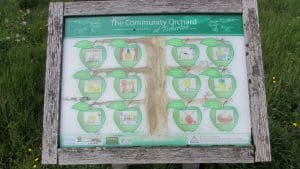
By Richard Avery – Own work, CC BY-SA 4.0, https://commons.wikimedia.org/w/index.php?curid=79112451
It’s important not to damage the plants too much especially if it’s on public property, so please only harvest a small amount from each individual plant. It is legal to pick from branches that overhang a public right of way, but it’s absolutely not legal to cross the boundary into somebody’s garden – and if you are asked to stop or leave, you should do so immediately. Please don’t be the reason that No Foraging signs go up everywhere!
Some park and garden favourites include trees and shrubs such as Ornamental Cherry, Magnolia, Stags Horn Sumac, Rowan, Apple, Hawthorn, Sea Buckthorn, Black Elder, Whitebeam and Mahonia. Pansy, Fuschia. Honey Fungus is notorious for attacking ornamental fruit trees – bad news for gardeners but potential dinner for you.

By Ввласенко – Own work, CC BY-SA 3.0, https://commons.wikimedia.org/w/index.php?curid=76836864
Hedges and boundaries:
Hawthorn, Blackthorn /Damson, Oak, Ash, Elder. Long Grass species at the base. Himalayan balsam spreads rapidly anywhere that is hard to mow or strim

By M J Richardson, CC BY-SA 2.0, https://commons.wikimedia.org/w/index.php?curid=14158506
Waste ground, cycleways, canals, old railways –
Birch and Elder are usually the first pioneer trees, their seeds blown in on the wind in the case of Birch and dropped in bird poo in the case of Elder. Hawthorn is another bird favourite, and isn’t far behind, though it’s much slower growing. Stags horn sumac spreads in clumps from gardens and ornamental planting. Nettles and Brambles, Rosebay Willowherb and Wild Raspberry can form big patches within a few years. Giant Hogweed is both a serious safety concern, but also technically edible if handled with care. Personally, I wouldn’t risk it! It can grow anywhere, but particularly likes damper ground like rivers and canals. Himalayan balsam also likes damp areas and is extremely invasive, so whatever you can harvest will make space for more biodiversity. Fungi such as Oyster mushrooms and Chicken of the woods may appear on mature trees, Jelly Ear colonises Elder, and Birch Polypore will be specifically on Birch. Fly Agarics and Bay boletes have mycorhizal relationships around young trees.
Secondary Woodland:
If land is left alone long enough, those wasteland coloniser plants and trees will start to become new woodland. It takes a while to build up biodiversity, but whether it’s been planted deliberately by people or just developed by itself on a piece of derelict land, more species will arrive. You can expect any or all of the Hedgerow and waste ground species, with long grass species round the edges. In addition, look for mature Sycamore and Ash which often become dominant due to their prolific seeds. The longer the trees have been there, the greater fungal diversity will appear, forming mycorhizal relationships with the tree roots and breaking down the leaf litter and dead wood. You can hope to see Puffballs, Blushers, Shaggy ink caps, Common Ink caps, Agaricus species at ground level; Oyster mushrooms, Velvet Shanks and Chicken of the Woods on older trees. Clustered Domecap can be found on disturbed ground, If the woodland is very damp and dominated by willow, you may find patches of Scarlet Elf Cups, a colourful winter treat. Invasive 3 Corner Leek and other allium species such as Wild Garlic will start to spread if introduced.
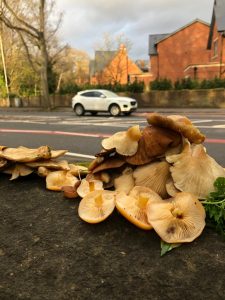
Ancient Woodland:
it might seem crazy, but you honestly might be lucky enough to stumble on a tiny sliver of ancient woodland species even in a very built up area. What is crucial for these species survival is that the soil has remained largely undisturbed for over 400 years, and that there has been some continuous tree cover even if the individual trees aren’t that old. Typically it will be a small strip along the boundary of a wood that used to be much bigger, but where the boundary has remained in place even after the main wood has been cut down. Or a patch of land too steep or awkward or boggy to have ever been ploughed or built on – so steep sided cloughs or gullies are well worth a look. Wild Garlic is a nice edible clue, as it hates ground disturbance, as do English Bluebells ( though if hybridised with the invasive Spanish bluebells this muddies the evidence a little bit). The definitive list of Ancient Woodland Indicator species would vary according to where you are – some are so rare now that they have a very limited range. This page can give some examples . In terms of foraging, as long as it’s a big healthy patch you don’t need to feel bad about taking a few leaves of Wild Garlic. However if you think you may have stumbled on some of these other rare and precious species, please don’t damage them – the site should probably be protected and your local Wildlife Trust may be able to advise further.
Local people advocating for green spaces and proving that they are useful and valued by the community is a powerful force for making sure those spaces stay accessible and those plant and fungi species are protected. Urban areas are often overlooked in terms of their conservation value, but the more you tune in and look around the more likely you are to discover something really interesting and special, as well as find good patches to pick up a free and sustainable lunch. So what are you waiting for? Wherever you live, there is bound to be something good just round the corner from your home.





